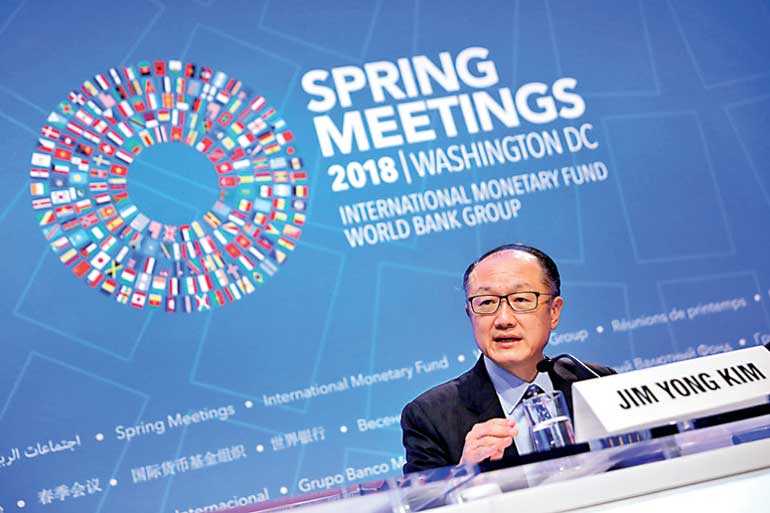Wednesday Mar 05, 2025
Wednesday Mar 05, 2025
Monday, 23 April 2018 00:00 - - {{hitsCtrl.values.hits}}
WASHINGTON (Reuters): The World Bank’s shareholders on Saturday endorsed a $13 billion paid-in capital increase that will boost China’s shareholding but bring lending reforms that will raise borrowing costs for higher-middle-income countries, including China.

World Bank President Jim Yong Kim speaks at a news conference ahead of the spring meeting of the IMF and World Bank in Washington, U.S., April 19, 2018. REUTERS
The multilateral lender said the plan would allow it to lift the group’s overall lending to nearly $80 billion in fiscal 2019 from about $59 billion last year and to an average of about $100 billion annually through 2030.
“We have more than doubled the capacity of the World Bank Group,” the institution’s president, Jim Yong Kim, told reporters during the International Monetary Fund and World Bank spring meetings in Washington.
“It’s a huge vote of confidence, but the expectations are enormous.” The hard-fought capital hike, initially resisted by the Trump administration, will add $7.5 billion paid-in capital for the World Bank’s main concessional lending arm, the International Bank for Reconstruction and Development. Its commercial-terms lender, the International Finance Corp, will get $5.5 billion paid-in capital, and IBRD also will get a $52.6 billion increase in callable capital.
The bank agreed to change IBRD’s lending rules to charge higher rates for developing countries with higher incomes, to discourage them from excessive borrowing.
IBRD previously had charged similar rates for all borrowers, and US Treasury officials had complained that it was lending too much to China and other bigger emerging markets.
US Treasury Secretary Steven Mnuchin said earlier on Saturday that he supported the capital hike due to the reforms that it included. The last World Bank capital increase came in 2010. The current hike comes with cost controls and salary restrictions that will hold World Bank compensation to “a little below average” for the financial sector, Kim said.
He added that there was nothing specific in the agreement that targeted a China lending reduction, but he said lending to China was expected to gradually decline.
In 2015, China founded the Asian Infrastructure Investment Bank, and lends heavily to developing countries through its government export banks.
The agreement will lift China’s shareholding in IBRD to 6.01 percent from 4.68 percent, while the US share would dip slightly to 16.77 percent from 16.89 percent. Washington will still keep its veto power over IBRD and IFC decisions.
Kim said the increase was expected to become fully effective by the time the World Bank’s new fiscal year starts on July 1. Countries will have up to eight years to pay for the capital increase.
The US contribution is subject to approval by Congress.
Discover Kapruka, the leading online shopping platform in Sri Lanka, where you can conveniently send Gifts and Flowers to your loved ones for any event including Valentine ’s Day. Explore a wide range of popular Shopping Categories on Kapruka, including Toys, Groceries, Electronics, Birthday Cakes, Fruits, Chocolates, Flower Bouquets, Clothing, Watches, Lingerie, Gift Sets and Jewellery. Also if you’re interested in selling with Kapruka, Partner Central by Kapruka is the best solution to start with. Moreover, through Kapruka Global Shop, you can also enjoy the convenience of purchasing products from renowned platforms like Amazon and eBay and have them delivered to Sri Lanka.
Discover Kapruka, the leading online shopping platform in Sri Lanka, where you can conveniently send Gifts and Flowers to your loved ones for any event including Valentine ’s Day. Explore a wide range of popular Shopping Categories on Kapruka, including Toys, Groceries, Electronics, Birthday Cakes, Fruits, Chocolates, Flower Bouquets, Clothing, Watches, Lingerie, Gift Sets and Jewellery. Also if you’re interested in selling with Kapruka, Partner Central by Kapruka is the best solution to start with. Moreover, through Kapruka Global Shop, you can also enjoy the convenience of purchasing products from renowned platforms like Amazon and eBay and have them delivered to Sri Lanka.